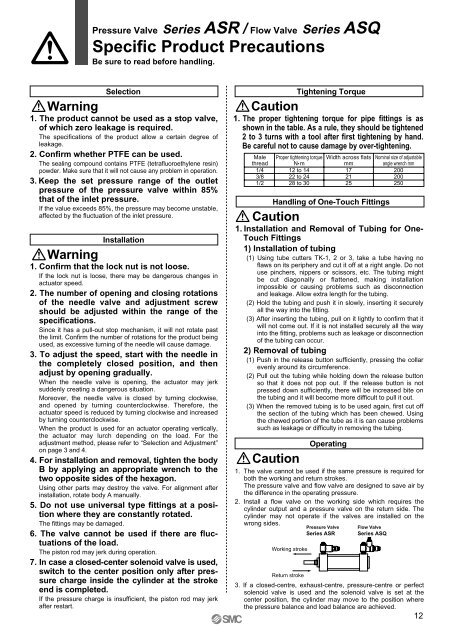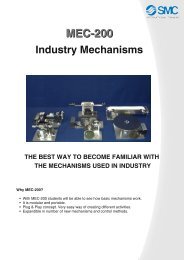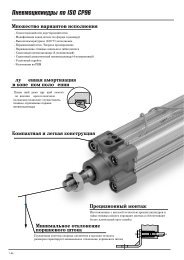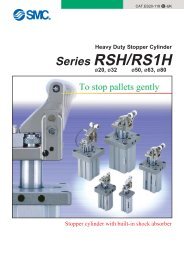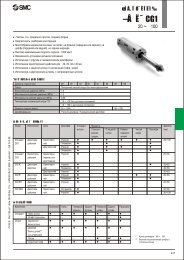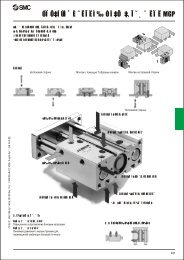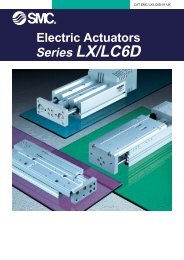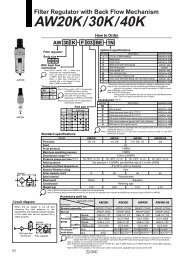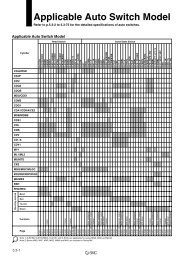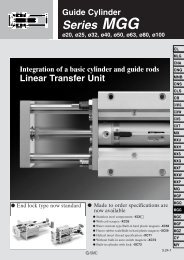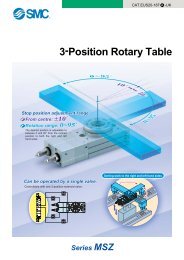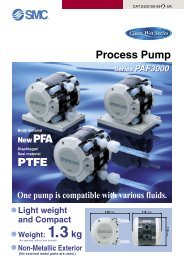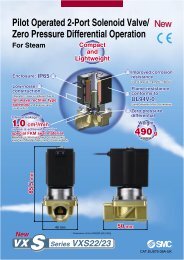ASR/ASQ - SMC
ASR/ASQ - SMC
ASR/ASQ - SMC
Create successful ePaper yourself
Turn your PDF publications into a flip-book with our unique Google optimized e-Paper software.
Pressure Valve Series <strong>ASR</strong> / Flow Valve Series <strong>ASQ</strong>Specific Product PrecautionsBe sure to read before handling.Warning1. The product cannot be used as a stop valve,of which zero leakage is required.The specifications of the product allow a certain degree ofleakage.2. Confirm whether PTFE can be used.The sealing compound contains PTFE (tetrafluoroethylene resin)powder. Make sure that it will not cause any problem in operation.3. Keep the set pressure range of the outletpressure of the pressure valve within 85%that of the inlet pressure.If the value exceeds 85%, the pressure may become unstable,affected by the fluctuation of the inlet pressure.WarningSelectionInstallation1. Confirm that the lock nut is not loose.If the lock nut is loose, there may be dangerous changes inactuator speed.2. The number of opening and closing rotationsof the needle valve and adjustment screwshould be adjusted within the range of thespecifications.Since it has a pull-out stop mechanism, it will not rotate pastthe limit. Confirm the number of rotations for the product beingused, as excessive turning of the needle will cause damage.3. To adjust the speed, start with the needle inthe completely closed position, and thenadjust by opening gradually.When the needle valve is opening, the actuator may jerksuddenly creating a dangerous situation.Moreover, the needle valve is closed by turning clockwise,and opened by turning counterclockwise. Therefore, theactuator speed is reduced by turning clockwise and increasedby turning counterclockwise.When the product is used for an actuator operating vertically,the actuator may lurch depending on the load. For theadjustment method, please refer to “Selection and Adjustment”on page 3 and 4.4. For installation and removal, tighten the bodyB by applying an appropriate wrench to thetwo opposite sides of the hexagon.Using other parts may destroy the valve. For alignment afterinstallation, rotate body A manually.5. Do not use universal type fittings at a positionwhere they are constantly rotated.The fittings may be damaged.6. The valve cannot be used if there are fluctuationsof the load.The piston rod may jerk during operation.7. In case a closed-center solenoid valve is used,switch to the center position only after pressurecharge inside the cylinder at the strokeend is completed.If the pressure charge is insufficient, the piston rod may jerkafter restart.CautionTightening Torque1. The proper tightening torque for pipe fittings is asshown in the table. As a rule, they should be tightened2 to 3 turns with a tool after first tightening by hand.Be careful not to cause damage by over-tightening.Malethread1/43/81/2Proper tightening torqueN•m12 to 1422 to 2428 to 30Handling of One-Touch FittingsCautionWidth across flatsmm172125Nominal size of adjustableangle wrench mm2002002501. Installation and Removal of Tubing for One-Touch Fittings1) Installation of tubing(1) Using tube cutters TK-1, 2 or 3, take a tube having noflaws on its periphery and cut it off at a right angle. Do notuse pinchers, nippers or scissors, etc. The tubing mightbe cut diagonally or flattened, making installationimpossible or causing problems such as disconnectionand leakage. Allow extra length for the tubing.(2) Hold the tubing and push it in slowly, inserting it securelyall the way into the fitting.(3) After inserting the tubing, pull on it lightly to confirm that itwill not come out. If it is not installed securely all the wayinto the fitting, problems such as leakage or disconnectionof the tubing can occur.2) Removal of tubing(1) Push in the release button sufficiently, pressing the collarevenly around its circumference.(2) Pull out the tubing while holding down the release buttonso that it does not pop out. If the release button is notpressed down sufficiently, there will be increased bite onthe tubing and it will become more difficult to pull it out.(3) When the removed tubing is to be used again, first cut offthe section of the tubing which has been chewed. Usingthe chewed portion of the tube as it is can cause problemssuch as leakage or difficulty in removing the tubing.CautionOperating1. The valve cannot be used if the same pressure is required forboth the working and return strokes.The pressure valve and flow valve are designed to save air bythe difference in the operating pressure.2. Install a flow valve on the working side which requires thecylinder output and a pressure valve on the return side. Thecylinder may not operate if the valves are installed on thewrong sides.Working strokeReturn strokePressure ValveSeries <strong>ASR</strong>Flow ValveSeries <strong>ASQ</strong>3. If a closed-centre, exhaust-centre, pressure-centre or perfectsolenoid valve is used and the solenoid valve is set at thecenter position, the cylinder may move to the position wherethe pressure balance and load balance are achieved.12


